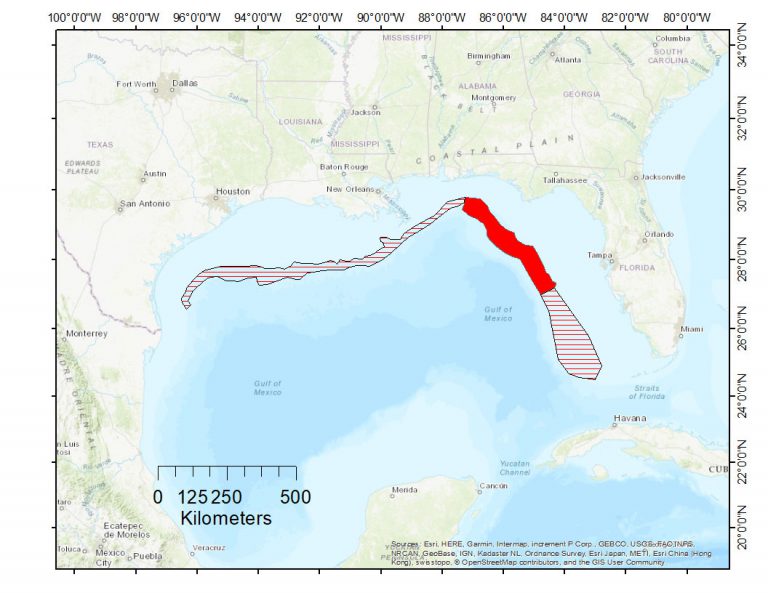Full Title: Trophic Interactions and Habitat Requirements of Gulf of Mexico Rice’s Whales
This project developed a comprehensive ecological understanding of Rice’s whales, including the physical, oceanographic, and biological features defining critical habitat and their ecological role in Gulf of Mexico marine food webs.
The Team: Lance P. Garrison (Lead Investigator, NOAA, lance.garrison@noaa.gov) Melissa Soldevilla (NOAA), Keith Mullin (NOAA), John Hildebrand (Scripps Institution of Oceanography, University of California San Diego), Michael Heithaus (Florida International University), and Jeremy Kiszka (Florida International University)
Technical Monitor: Vicki Cornish (vcornish@mmc.gov) and Barb Zoodsma (barb.zoodsma@noaa.gov)
Federal Program Officer/Point of Contact: Frank Parker (frank.parker@noaa.gov)
This project began in June 2017 and ended in May 2021.
Award Amount: $ 2,312,275
Why it matters: The Gulf of Mexico Rice’s whale population is estimated at 33 individuals and very little is known about this species. This project will gather and share information on how this small, resident population of whales relies on the northeastern Gulf of Mexico food web and will provide critical information to managers for recovery and restoration activities. This project will also examine an open ocean food web in the Gulf of Mexico and determine how it supports a range of species including finfish and rare whales.
What the team did: Using visual and acoustic monitoring, environmental measurements, collection of tissues from free-swimming whales, studies of prey distribution and composition, and deployment of animal-borne telemetry tags, the investigators will develop models and conduct analyses that provide information to managers and inform restoration and population recovery activities.
Summary of Outcome: In this study, we employed a multi-faceted approach to better understand the trophic ecology and habitats of this species. During three large vessel cruises, we employed visual and passive acoustic monitoring of whales, environmental sampling, scientific echosounder sampling, trawl sampling of prey, biopsy sampling for genetic and stable isotope analyses, photogrammetry from UAS systems, photo-identification studies, deployment of animal-borne tags, and eDNA methods. We integrated these data with visual survey data and photo-identification data collected by that National Marine Fisheries Service over the last two decades. The study demonstrated that Rice’s whales occur in regions of elevated productivity associated with upwelling of intermediate depth water onto the outer continental shelf and seasonal inputs of high productivity surface waters from coastal sources. Within the core habitat, dynamic oceanographic conditions support spatially and temporally variable aggregations of prey including fish occurring in dense schools in near-bottom waters at depths of 200-300m. Telemetry tags demonstrate that whales forage by diving nearly continuously during daylight hours. While feeding, whales typically undertake 1-2 lunges per dive and execute stereotypical behaviors that may be associated with the detection and aggregation of prey. Based upon stable isotope analysis and trawl data, it appears that the primary prey species for Rice’s whales are a schooling demersal fish, Ariomma bondi, that typically ranges from 100-200mm in body length. Other prey species include small, vertically migrating fish and squids. Photographic data collected during the current study and previous studies demonstrate considerable variability in the body and skin condition of individual animals over time. Energy budgets developed from the integration of tag data, trawl and acoustic prey distribution data, diet information, and prey proximate composition will help to assess the degree to which Rice’s whales are prey resource limited. The results from this study are currently being used to inform management and conservation actions, the development of recovery plans, and the identification of critical habitat as required under the Endangered Species Act.

From the seminar “The Trophic Ecology and Habitat of the Endangered Gulf of Mexico Bryde’s Whale (Balaenoptera edeni)”
Presenter: Dr. Lance Garrison, National Oceanic and Atmospheric Administration
Other Resources
- New research sheds light on the endangered Gulf of Mexico Bryde’s Whale
- NOAA Fisheries Science Blog: Summer Survey to Study the Trophic Ecology of Gulf of Mexico Bryde’s Whales – Post 1. NOAA Fisheries. Published 10 June 2019.
- NOAA Fisheries Science Blog: Summer Survey to Study the Trophic Ecology of Gulf of Mexico Bryde’s Whales – Post 2. NOAA Fisheries. Published 10 July 2019.
- Finding of No Significant Impact, Rice’s Whales
- NMFS Biological and Conference Opinion, Rice’s Whales
- Environmental Assessment for “Trophic Interactions and Habitat Requirements of Gulf of Mexico Bryde’s Whales”
- FONSI for “Trophic Interactions and Habitat Requirements of Gulf of Mexico Bryde’s Whales”
- Presentation from 2019 Gulf of Mexico Oil Spill and Ecosystem Science Conference
- In 2021, the Rice’s whale was recognized as a new species. Learn more about NOAA’s ongoing comprehensive research here.
- Project Website: Trophic Interactions and Habitat Requirements of Gulf of Mexico Rice’s Whales Developing a comprehensive ecological understanding of the endangered Rice’s whale, formerly known as Gulf of Mexico Bryde’s whale. NOAA Fisheries. Published 8 Feb 2022
 Official websites use.gov
A .gov website belongs to an official government organization in the United States.
Official websites use.gov
A .gov website belongs to an official government organization in the United States.
 Secure .gov websites use HTTPS
A lock or https:// means you’ve safely connected to the .gov website. Share sensitive information only on official, secure websites.
Secure .gov websites use HTTPS
A lock or https:// means you’ve safely connected to the .gov website. Share sensitive information only on official, secure websites.